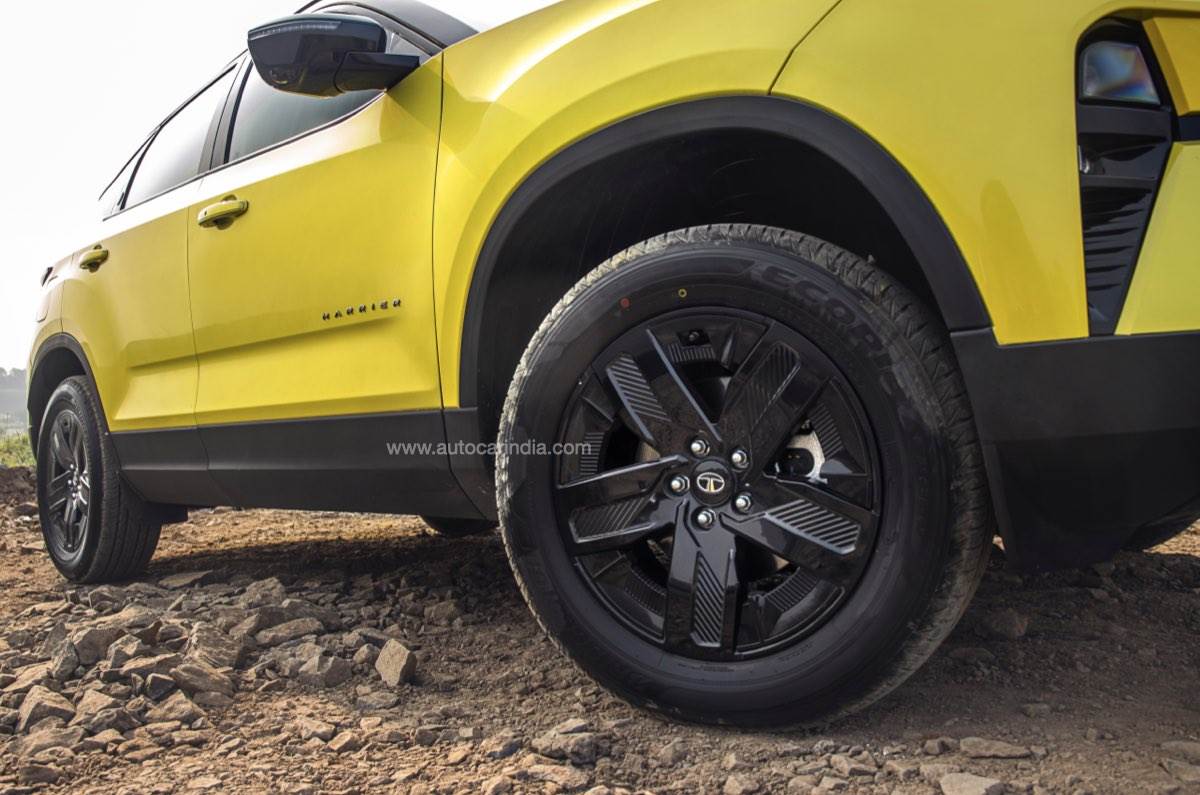Comprehensive update makes it a far more complete package, and you’d be happy to spend big money on it.
You really have to hand it to Tata Motors for constantly refreshing the Harrier since its launch in 2019. The model got a power upgrade, an automatic transmission and the all-important addition of a panoramic sunroof just a year after launch. Then there have been a couple of special editions, with each one debuting a feature or two that make it to the standard model in due course. In fact, just a couple of months ago came the Harrier Red Dark Edition with ADAS.
What we have here, however, is the most comprehensive update to the Harrier yet. It’s new on the outside, it gets a redone interior, there’s a whole lot more tech and there are some key mechanical changes as well. Should you be interested? In a word, yes.
Tata Harrier facelift exterior styling
Let’s talk styling first. Like a typical facelift, changes here are restricted to soft parts like the lights and bumpers, but the combined effect of all the new elements is an edgier and even more striking looking Harrier.
Taking centre stage up front is a larger grille that gets the requisite dose of flash with metal-like embellishments. The familiar, slim Daytime Running Lamps on top have been pinched further and now come connected by a light bar. This new arrangement has allowed the inclusion of a cool welcome animation, which is a big feel-good feature in its own right. Talking lights, the main headlights are now LED units and come vertically-oriented amidst more prominent angular cutouts on the bumper. An aero-enhancing air passage from the bumper to the wheel wells has also been included. Lower down, there’s a larger surround for the air dam and a wider, chunkier scuff plate as well.
Changes in profile are limited, and it’s the new design for the wheels that’ll be your biggest giveaway of this being the updated Harrier. Notably, the wheels are now a size larger. 17 inches is the base size now, mid- and top-spec variants ride on 18 inchers, while the Dark Edition versions get 19 inchers! This aside, there’s bold Harrier lettering on the doors and a badge on the C pillar to commemorate Tata Motors’ journey to 50 lakh sales.
Styling at the back has been freshened up with reprofiled tail-lamps and the incorporation of a full-width light bar. The bumper has also been given a makeover with new vertically-oriented elements. However, if you look closely, fit and finish isn’t perfect, there are still some ill-fitting bits like the misaligned rubber door seals.
Worth bringing in is that the Harrier will be offered in four trims – personas as Tata Motors calls them – that are identifiable on the outside by their wheels, detailing and exterior colours. The version featured here is the top-spec Fearless. And, you know what? Its Sunlit Yellow paint shade works.
Tata Harrier facelift interior and features
Just as with the exterior, the Harrier’s interior also sees some big changes. There’s a new, nice-to-hold steering wheel with a gloss black boss and an illuminated Tata logo; the dashboard has been refreshed with slimmer AC vents; and adding distinction are the new persona-based interior colour themes. Our Harrier Fearless+ in Sunlit Yellow sported a yellow panel on the dash as well as yellow contrast stitching and grab handles. It’s loud and won’t be to everyone’s taste, but other exterior colours get more sober interior tones. My pick is the brown on black theme for the Adventure persona Harrier.
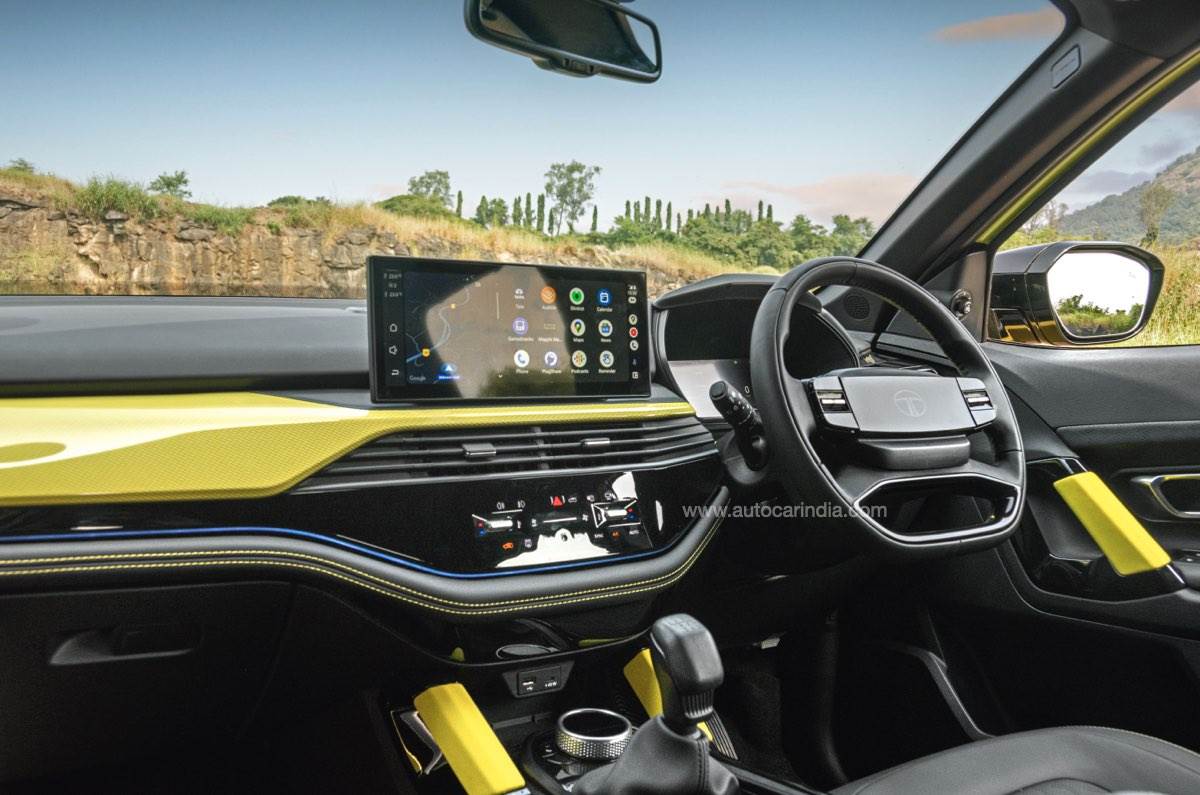
New screens and tech enhance interior look. Flamboyant body colour elements on Fearless trim.
But more than the new colours it’s the new tech that does its bit to uplift the look of things inside. There’s a new digital driver’s display that has neat graphics and is easy to use. At 10.25 inches it’s large too, but some of the effect is lost because it is set quite far back in the deep instruments binnacle. The screen’s ability to display a connected phone’s map and that too in full screen is a huge plus though.
Perhaps the most significant tech update on the new Harrier is the new 12.3-inch touchscreen that feels a few generations superior to the older 8.8-inch unit. The latest unit is slick, it’s responsive, it’s vibrant and packs in a whole lot of features as well. There’s wireless Android Auto and Apple CarPlay, a superb 360-deg camera which gives you a 3D image of the vehicle in its surroundings, and the screen is also your display for the onboard air purifier and JBL sound modes.There are 13 sound modes and they are nicely tuned to get the most out of the audio system. In all, the five speaker (including a new one behind the dash), four tweeter and subwoofer setup delivers a rich, deep and satisfying sound.
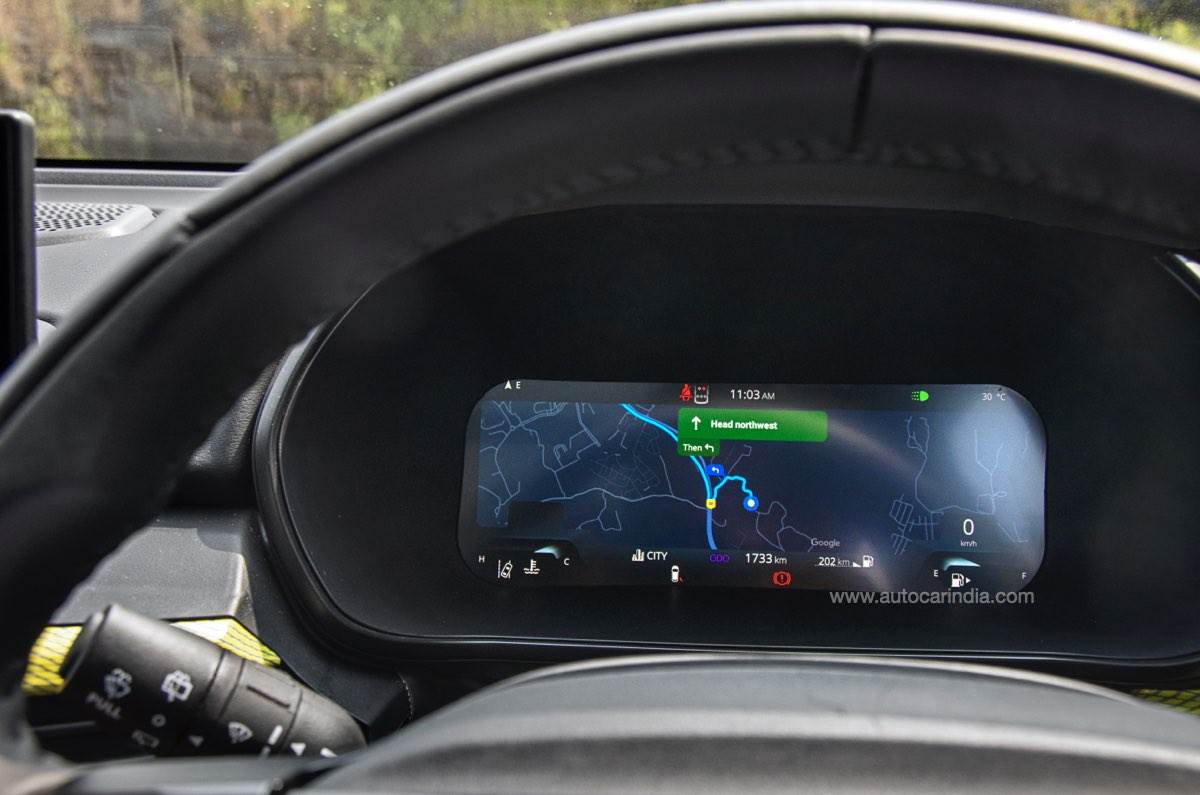
10.25-inch digital dials look great and can display a connected phone’s map.
Also part of the package is ambient lighting on the dash and around the sunroof. Interestingly, while the hues can be changed via the touchscreen, you don’t get a full spectrum of colours to choose from and the palette depends on the persona you’ve opted for.
The centre console for the climate control system is also redone and now sits in a gloss black panel. Save for temperature settings for the new dual-zone climate control that can be adjusted via toggles, all other functions are touch operated.
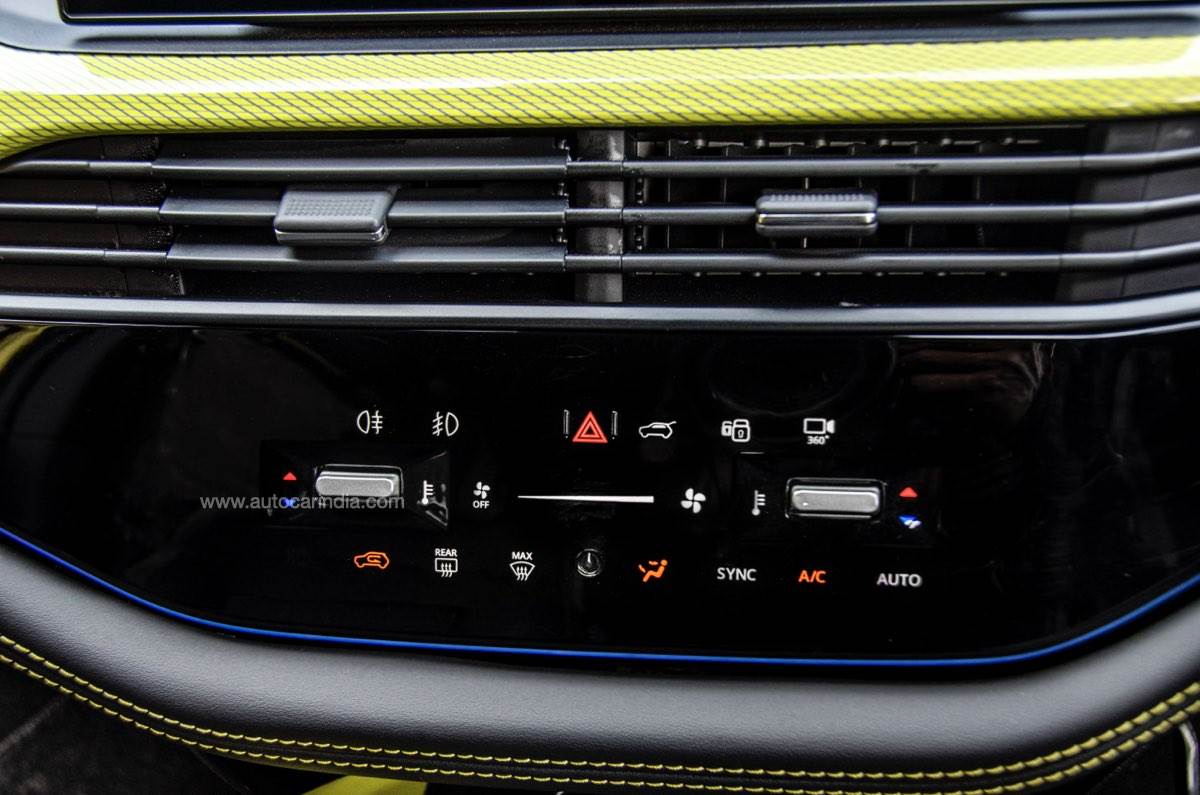
New HVAC console gets toggles for temperature control, but touch-operated blower control is fiddly.
These controls stay hidden from view when the car is off and only light up when powering on. The arrangement looks cool but isn’t perfect in execution. The touch slider for the blower control is fiddly to use and will need you to take your eyes off the road to get it right. Using voice commands is a workaround, provided you are patient enough to have a conversation with your car. The Harrier understands voice commands in six languages and the option to control the panoramic sunroof by voice is no less than a party trick.
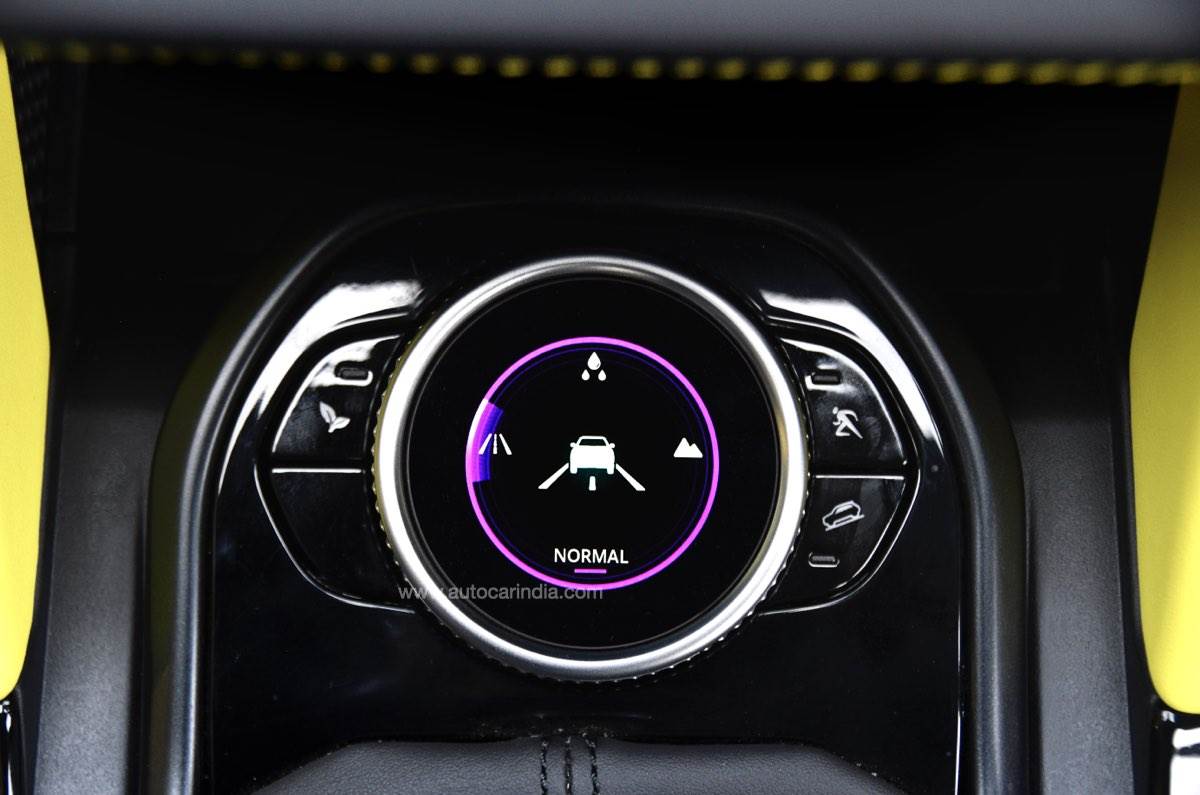
Terrain mode dial gets inset screen. It isn’t easy to access.
Of the other things, the Harrier gets a new knurled rotary selector ahead of the gear lever for the Terrain modes. As premium as the dial with its inset display looks, it also reveals an ergonomic oversight – your hand will foul with the gear lever when using the dial. The base of the centre console in its entirety could do with a rethink because you are forced to contend with a wireless phone charger that’s awkward to access and USB charging slots that aren’t easy to plug into.
On the subject of ergonomics, despite Tata Motors repositioning the pedals to address the issue of the driver’s left knee making contact with the dash, the problem persists. Also on my wish list would be a roomier footwell – there’s no space to rest your clutch foot on the manual Harrier.
.jpeg&c=0)
Footwell doesn’t leave room to rest clutch foot; dash fouls with left knee as before.
As before, the Harrier’s front seats are nice and large, and the high seating gives a really commanding driving position. From behind the wheel, you get the feel of being in a big SUV and many will like the Harrier for just that. The driver’s seat gets six-way power adjust and memory, the front passenger seat gets powered adjust too, and both front seats are ventilated.
Perceived quality and fit-finish have taken a jump up with the update. All your typical contact points like the steering, the gear lever and door handles feel really nice to touch but if you do poke around you will find some scratchy plastics too. The bigger concern surrounds the extensive use of gloss black materials. What we’ve seen in other cars, at least, is that this surface is prone to scratches and also attracts a lot of smudges, and this may take quite a bit of extra care to keep clean.
As mentioned, a more convenient phone storage bay would be nice but this aside, the Harrier does well on space for small items. There are bottle holders on the doors, a large glovebox with useful compartments, cupholders at the centre console as well as a cooled box between the seats that also features USB A and C ports.
Tata Harrier facelift rear seat space and comfort
Not all that much has changed at the back of the updated Harrier, but it does get some new additions. For instance, the rear windows now get sunshades, which come really handy on a hot day. Also different are the airline-style rear headrests that can be wrapped around your head to prevent excessive side to side movement.
As before, the highlight at the rear is space. Six footers will be at ease and there’s also enough room for three adults to sit in comfort. What’s disappointing is that there’s no headrest for a middle passenger, though a three point seatbelt has been included now.
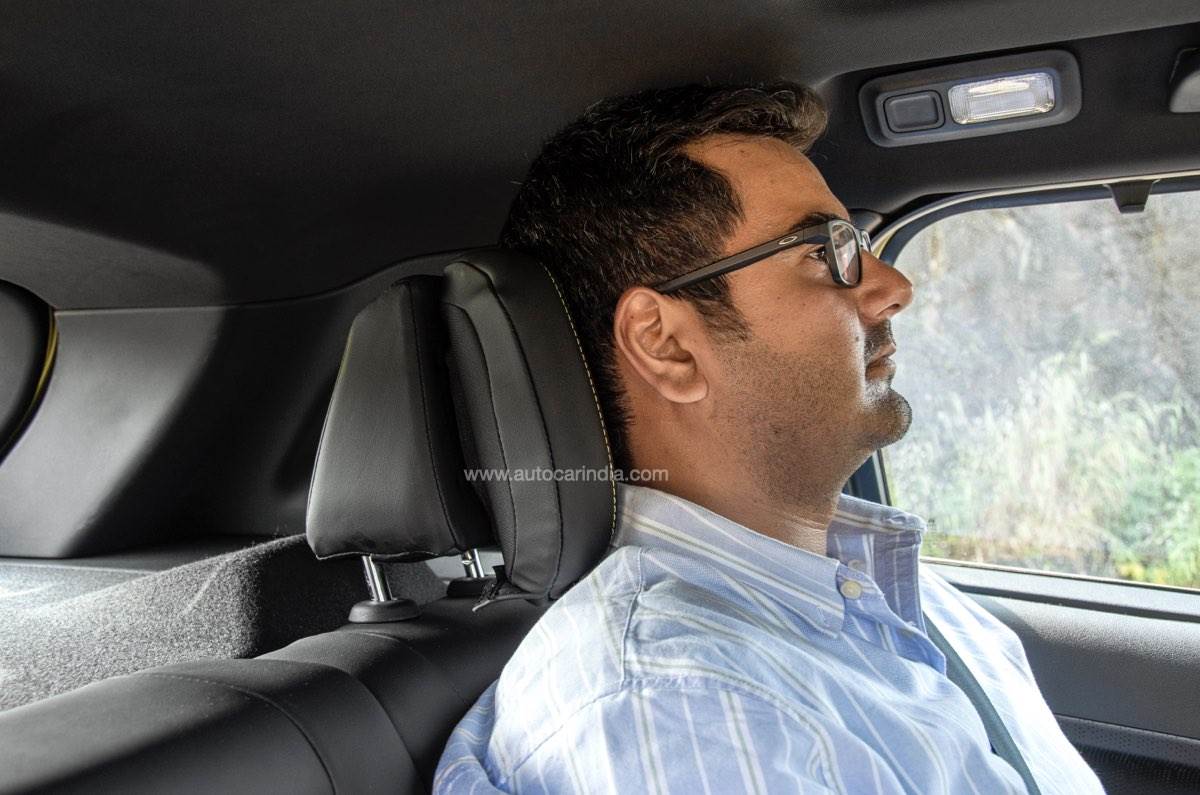
Adjustable rear headrests can be folded to wrap around your head for better support.
A dedicated blower control for the rear section would have been a nice addition but cooling is good. The rear vents mounted on the B-pillars do a good job of directing cool air to your face. All said, you’ll be comfortable for long hours on the back seat of a Harrier and there are enough provisions for your devices and odds and ends on a long journey. Storage spaces include two cup holders on the centre armrest, there’s a bay for your phone and what’s also handy is the shelf-like storage on the doors.
Tata Harrier facelift boot capacity
When it’s time to load luggage you’ll welcome the addition of a powered and gesture-controlled tailgate. The boot can accommodate big suitcases with ease and a marginally lower floor has actually resulted in space increasing by 20 litres to 445 litres. The rear seats can be folded down if you need more room too. As before, the spare is mounted under the body and is a 16-inch steel rim.
Tata Harrier facelift ride and handling
That’s that for the changed on the outside and inside. But what’s the updated Harrier like to drive? The switch from a hydraulic to an electric power steering, move to larger wheels, suspension tweaks, inclusion of rear disc brakes and a BS6.2 engine promise much.
Of these changes, it’s the improved steering that makes the biggest difference to the Harrier’s driving experience. You feel the benefits of the new arrangement almost immediately with far less steering effort required at parking speeds and during U-turns. And the benefits of the new steering setup extend to high speed environments as well. That inconsistent steering feel on the old Harrier (slack at centre followed by a sharp response with just a few degrees of lock) has been done away with, and you get a more connected driving experience, though there is still a fair bit of play around the straight-ahead position.
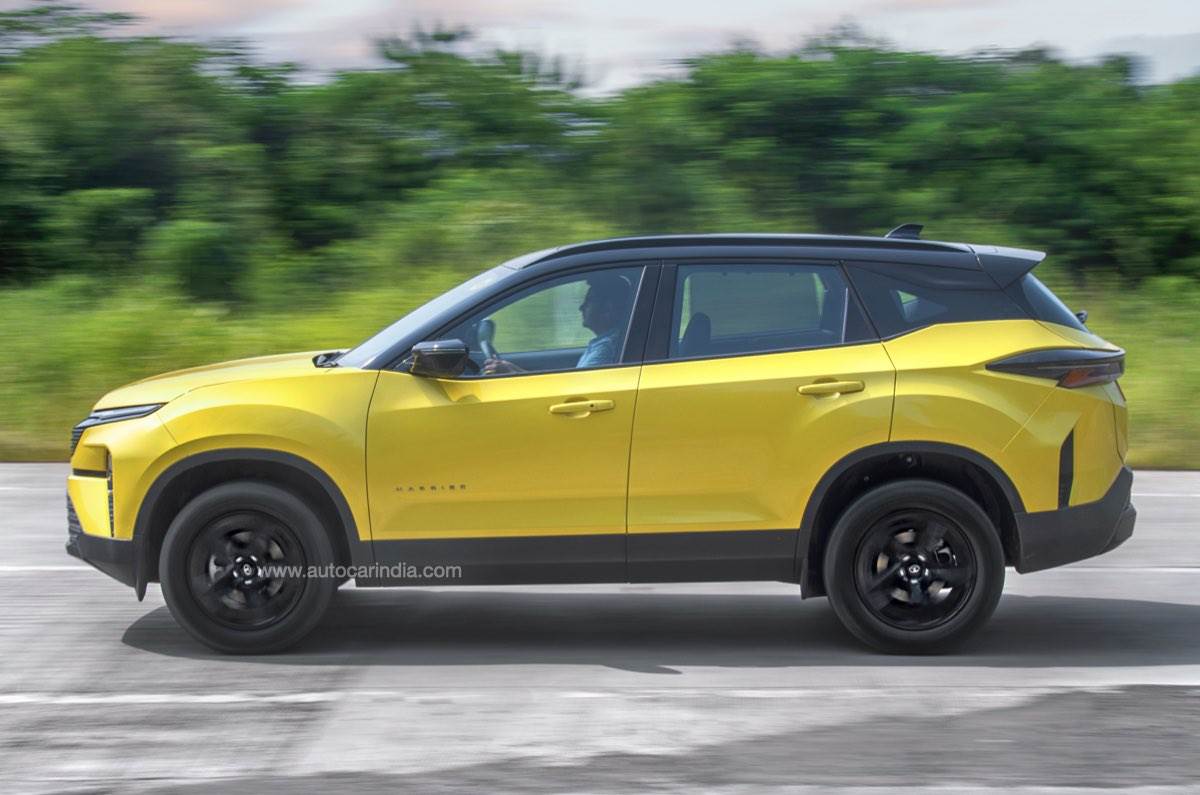
Familiar ride quality: firm at low speeds, great bump absorption and good high-speed stability.
Handling on the whole feels more sorted. Sport driving mode adds a bit more weight to the steering, which is nice when you’re driving faster. I’m also happy to report that steering kickback is no longer a problem on the Harrier.
Has the move to larger rims corrupted the Harrier’s ride? Actually, no. In fact, the updated Harrier feels pretty much the same on this front. On smaller surface imperfections, the Harrier still feels a bit jittery and a touch firm even. When the potholes become larger, the Harrier shines and takes the bumps like a champ. The ride also gets better the faster you go; it feels sure-footed at higher speeds, drives like the heavy car that it is, and it all comes together to give you great confidence.
Higher-spec versions of the Harrier now make the move to rear disc brakes. Braking performance with all four discs is good, but the feel from the pedal is a bit mushy. Under hard braking, there is a lot of pitch and there’s no escaping the Harrier’s sheer heft.
Tata Harrier facelift engine, gearbox and performance
First things first, the updated Harrier doesn’t get a petrol engine option as was widely expected. Tata’s upcoming 1.5-litre turbo-petrol engine is a good year or so away from joining the Harrier line-up. The Fiat-sourced diesel engine remains the sole engine on offer, but it is now BS6.2 compatible.
From behind the wheel, the 170hp, 350Nm, 2-litre diesel engine doesn’t feel any different to the earlier versions. And that’s because its characteristics remain the same: it’s got a strong mid-range, a wide powerband and generally feels like a powerful engine. On the flip side, refinement levels are still far from class best standards, and this engine groans and moans at low speeds and booms when you extend it.
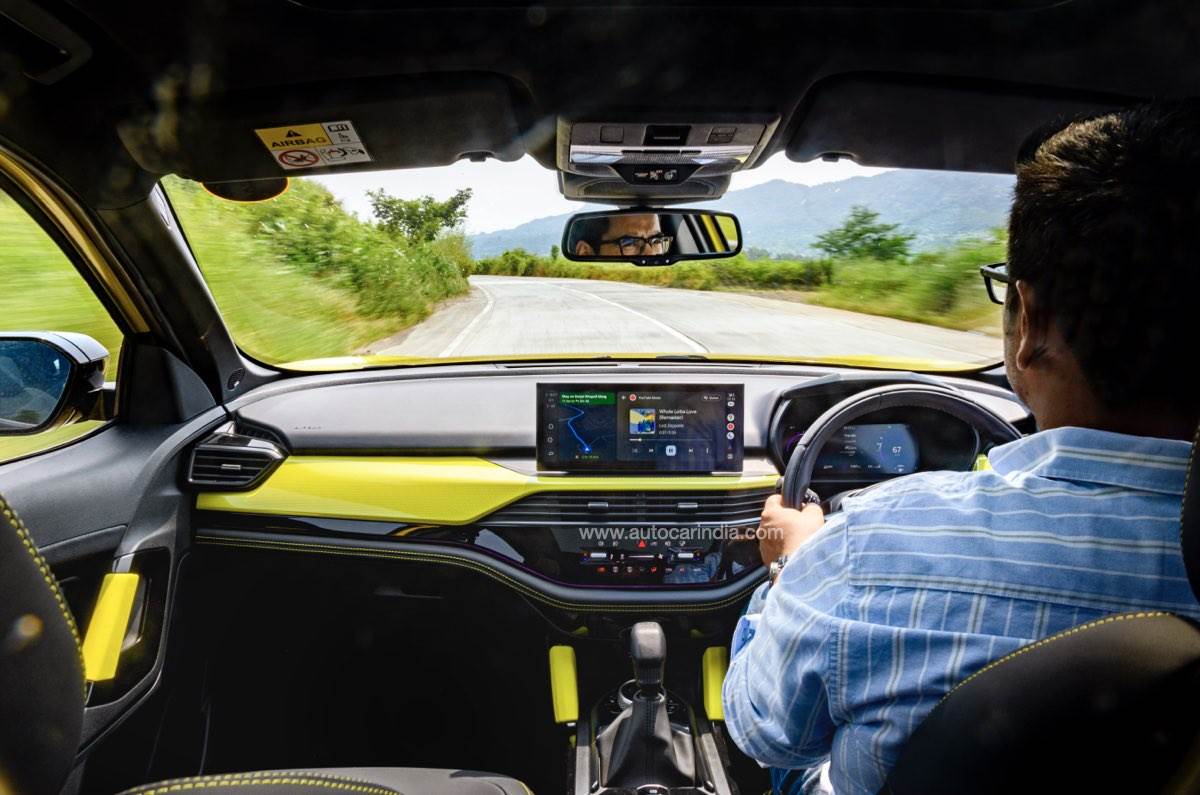
The updated steering has made living with the Harrier a whole lot easier.
Drive modes, namely Eco, City and Sport, are part of the package, and each mode has its own profile, with the throttle most responsive in Sport and most relaxed in Eco. There are Normal, Wet and Rough terrain modes too that tweak ESC characteristics for different conditions, but the front-wheel drive Harrier is no off-roader. However, it’ll do light trails with ease and has all the ground clearance you’d need.
As before, gearbox options include a six-speed manual and a six-speed torque converter automatic. We sampled the updated Harrier with a manual gearbox and found a slightly improved shift, although gear changes still need a bit of an effort. The bigger issue is the clutch that’s got a long travel and is tricky to modulate. Frankly, the manual is not the gearbox of choice if you’re interested in a Harrier.
Tata Harrier facelift safety and ADAS
The Tata Harrier feels tough though it’s yet to be rated by Bharat NCAP or Global NCAP, but sources tell is that it will be submitted for both programmes and a 5-star rating is the target.
Irrespective of which gearbox or persona you choose, all Harriers get 6 airbags, ESC, traction control, 3 point seatbelts for all seats, Isofix child seat mounts, tyre pressure monitoring system and more as standard. Higher-spec versions add in hill descent control, a driver knee airbag and also get a camera- and radar-based Advanced Driver Assistance systems or ADAS.
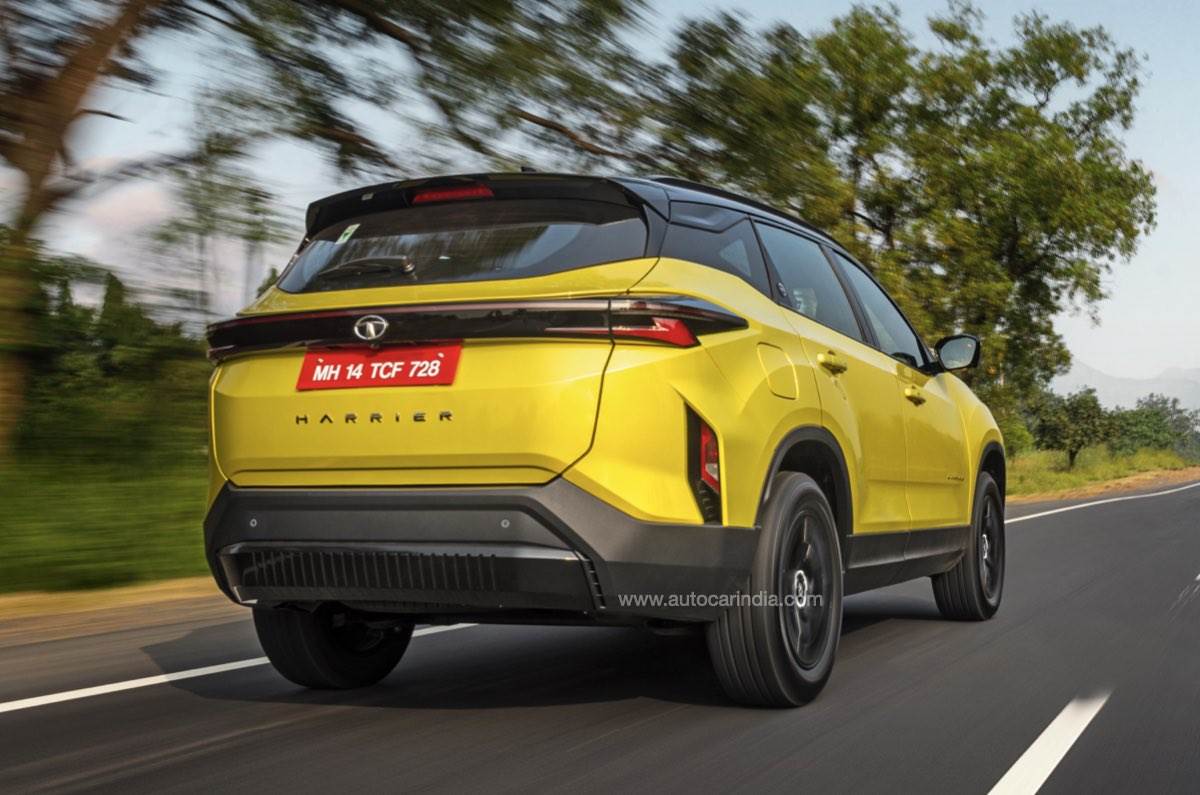
Performance from the engine remains strong, but refinement isn’t great for an SUV of this class.
The blind spot warning and blind view monitor (they relay a camera feed from the wing mirrors onto the centre screen) greatly enhance situational awareness, and features like cross traffic alert, auto high beam assist and traffic sign recognition are a boon in our conditions. The Harrier gets a lane departure warning too, and over the next few months, lane keep assist (that brings in steering intervention) will also be added. The feature will be rolled out to the initial batch of Harriers via a software update.
We didn’t dare test the autonomous emergency braking system, but missed the option to adjust distance settings for the forward collision warning function. Tailing a car close didn’t give a warning prompt when we expected it to. Unfortunately, we couldn’t experience adaptive cruise control, which is restricted to the automatics only. Just another reason to opt for the automatics, then.
Tata Harrier facelift expected price, verdict
The 2024 Harrier goes on sale on October 17 and it’s safe to assume a bump up in prices. We expect the range to start at Rs 16 lakh for the base Smart trim and top off at Rs 25 lakh for the fully loaded Fearless+ Dark Edition.
With the updates, Tata has addressed many of the Harrier’s weaknesses. The new steering makes the SUV far easier to live with, it’s taken a huge leap forwards in tech and there’s a newfound wow factor to the interior. At the same time, the new styling builds on the original design to fantastic effect.

However, a petrol engine is missed, and punchy as the diesel is, it’s not as refined as it ought to be. Looking at the big picture though, the Harrier is now a far more complete package and a Tata you’d be happy to spend big money on. Expect to see a lot of them on our roads.
Also See:





















